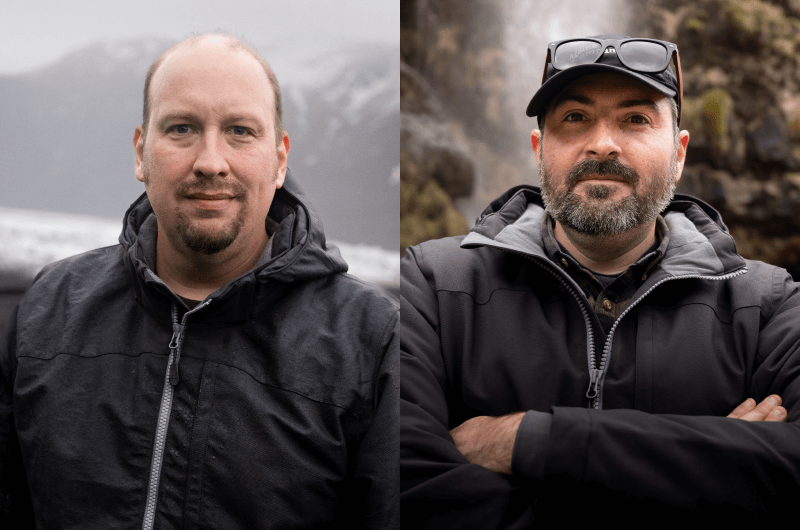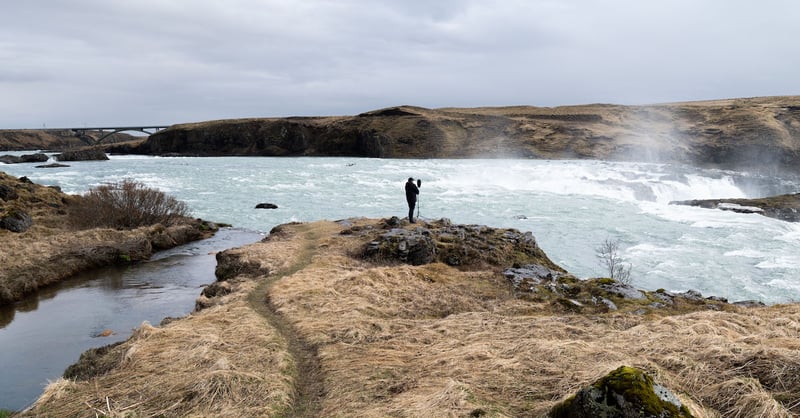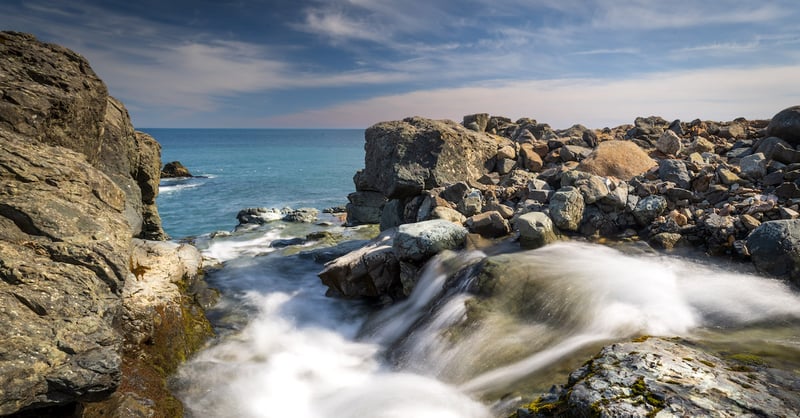Take an inside look at the recording process behind our newest library of immersive field recordings.
We’re excited to bring you Waves Wind Water Vol. 2 – our newest specialty library featuring immersive sound effects from some of the purest natural environments on Earth. Recordists Jason Strawley & Andrew Garraway journeyed to the remote shores of Iceland to record detailed soundscapes at dozens of diverse locations ranging from beaches to glaciers and everything in between – all in multiple formats for unparalleled flexibility.
Read our interview below to learn about Jason and Andrew's process and experience in recording this expansive and high-quality library.
What was your inspiration for creating this library?
Jason and Andrew: Mostly, we were looking for an excuse to travel to Iceland! We’ve been admiring the gorgeous landscapes and thriving music scene from afar for years. Besides the selfish agenda, Iceland seemed like an ideal location for the types of geophonic sounds we wanted to record. The waves, wind, and water in Iceland are cranked up to extremes. Bigger waves, stronger winds, colder waters! Also, not too much in the way of wildlife, people, or air traffic. So not only are the sounds more extreme, but they’re naturally cleaner from a noise pollution perspective. Finally, the Icelandic government and people are very friendly to production so everything came together nicely.
Can you describe your experience recording this library?
This being our biggest recording expedition to date, and given the remote nature of our recording destinations, we carried a primary and backup for every piece of gear. With the harsh conditions in mind we upgraded our wind and rain protection to industrial-strength stuff, which is bulky but 100% worth it. This meant hauling a ton of baggage and doing a carnet for the first time. We made sure our equipment and production insurance got extended to worldwide coverage. We were in contact with the Icelandic film commission to make sure everything was above-board. All the boring, grown-up stuff that real businesses have to do - but so important for a project this big.
To ensure that we got the full spectrum of soundscapes in Iceland we traveled the entire Ring Road counter-clockwise starting and ending in Reykjavik. We gave ourselves two weeks to complete the circuit. This means we could limit the travel time to our lodging on any given day and really commit to listening to the landscape instead of just getting from point A to point B. This allowed us to explore in a way that was very inspiring. Some of my favorite recordings were from random gravel roads that went off into the middle of nowhere or unexpected hikes that landed us in scenic locations well off the beaten path.
"Iceland seemed like an ideal location for the types of geophonic sounds we wanted to record. The waves, wind, and water in Iceland are cranked up to extremes. Bigger waves, stronger winds, colder waters!"

Andrew (left), Jason (right)
Any fun recording session stories to share?
Locals and travelers alike speak about the unpredictability of Icelandic weather. We went in the spring, which is one of the ‘shoulder’ seasons. Our thinking was that ice melt would result in a more dramatic soundscape - especially for the country’s many waterfalls. We were right! But what we couldn’t predict is that the weather is even more variable in the spring. We had sunny days in the high 60s (°F) that were suitable for shorts and t-shirts followed by a full-on blizzard with road closures, wind advisories, sub-freezing air temperatures and wind chills that went well into the negatives. Many locals would tell us "If you don’t like the weather, give it a minute.” So true!
What surprised you about creating this library?
Getting away from man-made noises in Iceland was fairly easy in the Spring. We didn’t have to get too far off the ring road to have long uninterrupted rolls. We were not, however, expecting the limited natural biophony to disturb so many recordings. Geese in particular are a sonic nuisance as they are nesting in the spring in preparation for the breeding season. Just two geese were able to match the volume of an entire flock, and would tend to circle for a while. They could easily slow down a 30 minute process to two hours while we settled in and stayed still long enough for them to forget about the perceived threat.
Why is this library useful for sound artists?
Pristine outdoor ambiences can be hard to come by simply because of the lengths one has to go to in order to avoid noise pollution. We made sure that our sounds were usable throughout the entire length of the recording by carefully choosing our locations and meticulously editing out the occasional unwanted noise so that the recordings are drag-and-drop simple for post pros.
What makes this library different from other sound libraries?
Our obsessive nature sets this apart from other sound libraries. We set very high standards for our own recordings as we use them ourselves for sound edits. We use the first Waves Wind Water library constantly, and through that usage were able to make a list of any gaps that we felt needed to be filled in the categories of Waves Wind and Water. We figure that if we need it, other sound editors might need it too. We were extraordinarily satisfied with the amount and quality of recordings we were able to source. It allowed us to be picky and target the final product to fill a need for the audio post world.
"Pristine outdoor ambiences can be hard to come by simply because of the lengths one has to go to in order to avoid noise pollution."

Can you provide any notable technical details about the recording of this library?
We used the Sennheiser AMBEO ambisonic mic in conjunction with the Sound Devices MixPre 6 for every sound in this library. We’ve written quite a bit about why this setup fits our workflow so well. This time around we added Cinela wind and rain protection to our kit. We had heard good things, but the practical reality of how well these products work in the field was astounding. Some of the winds we encountered in Iceland were so extreme I thought there was no way the recordings would be salvageable, but a little bit of cleanup in post and wow, it worked great! Our bigger problem was keeping the stand from flying away. We used locally sourced rocks and sometimes our own bodies to weigh down the stand.
Editing and mastering were done in Pro Tools with iZotope Neutron doing most of the heavy lifting for EQ and dynamics control. Plus, a little bit of RX to clean up the occasional bird or tourist. Honestly, this library was very easy to edit and master because of how pristine and quiet the locations were. I wish it were always this easy!
"Some of the winds we encountered in Iceland were so extreme I thought there was no way the recordings would be salvageable, but a little bit of cleanup in post and wow, it worked great!"

Available Now – Waves Wind Water Vol. 2












